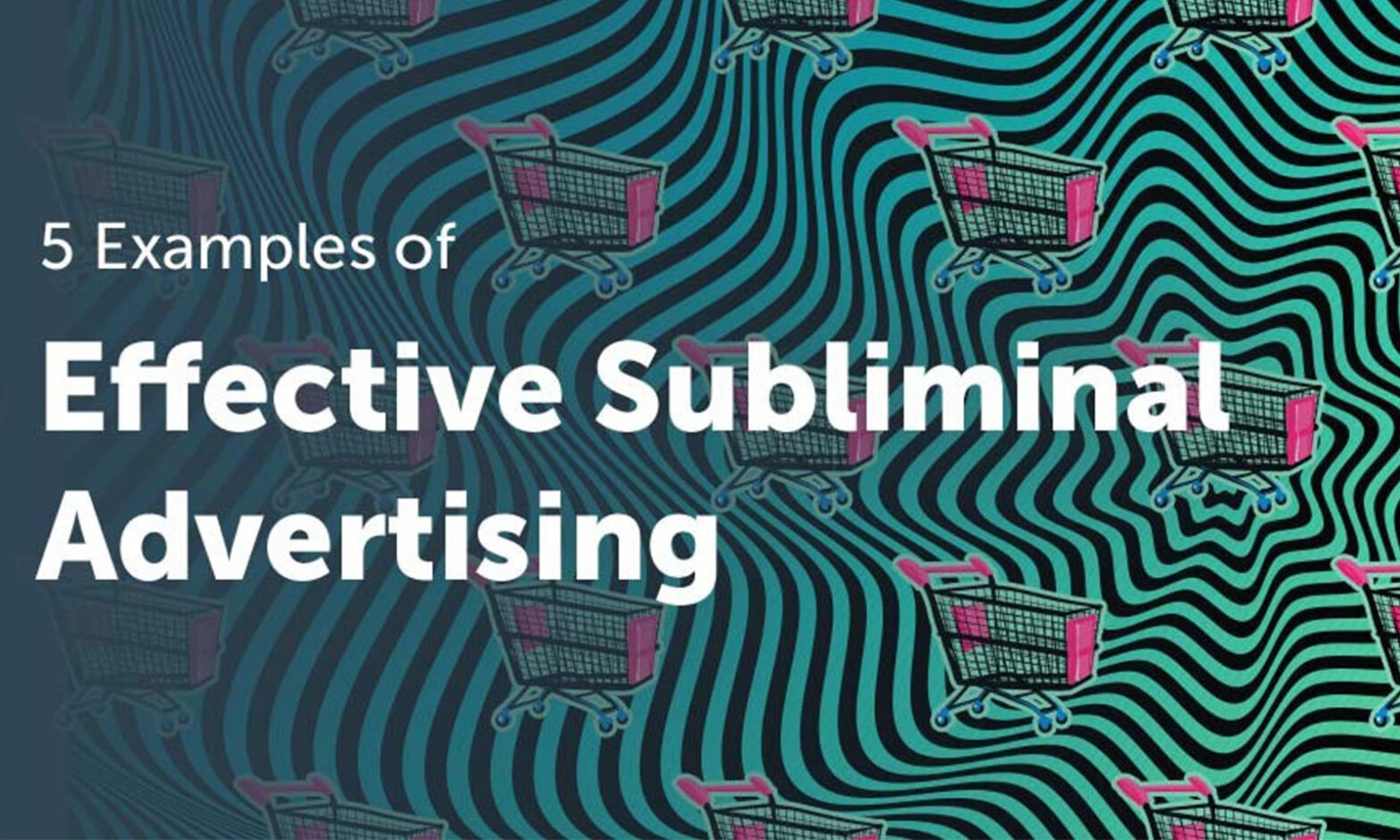For most everyday consumers, the idea of subliminal media messages sounds like something out of a sci-fi film. But for those of us in the world of marketing, subliminal messages in advertising are a widespread strategy used by companies of all types and sizes – and when done right, it can be effective.
In reality, the subliminal messaging often incorporated into advertising is far from the ominous examples shown in Hollywood films and TV series. But if you’re considering attempting to incorporate subliminal advertising into your marketing strategy, there are some things you’ll want to know first.
We’re taking a deep dive into the concept of subliminal messaging, discussing exactly what it is and why brands use it. Then, we’ll examine some examples of successful subliminal advertising, as well as a few attempts that went very, very wrong.
What is Subliminal Messaging?
Even if you’ve heard the term thrown around in pop culture, you might still be wondering: what are subliminal messages, really?
Essentially, subliminal messaging is a way to communicate a specific idea in such a way that bypasses your “mental radar,” aiming directly at your subconscious mind. In simplest terms, it’s an attempt to embed an idea in your mind without you even realizing it.
How is Subliminal Messaging Used in Advertising?
When it comes to advertising, subliminal messaging occurs when an advertiser tries to use images or sounds to influence the audience without viewers being aware of it. Ultimately, the goal is for the audience to walk away with a certain message in their mind – for example, the desire to visit a new coffee shop in town.
Even though using subliminal messages in advertising sounds like a sneaky tactic (and it can be), it’s mostly just a way for advertisers to influence consumers’ feelings and thoughts about a certain product or service. And when you think about it, isn’t that what all advertising aims to do?
There’s not necessarily any concrete evidence telling us whether subliminal advertising actually works. However, that certainly hasn’t stopped advertisers from using it to get their messages across.
Types of Subliminal Messaging
Experts typically break subliminal messaging into three main categories, each of which has varying possibilities in mediums such as radio, TV, and social media.
- Sub-audible messages include audio content that is inserted into another, different piece of audio. For example, a voice recording might be added to the audio of a song or interview, but at a very low volume that makes it nearly impossible to detect. Even though the volume makes the message very subtle, the listener’s brain may still “hear” it and store it within the subconscious.
- Sub-visual messages are made up of visual cues and can appear in TV, print, and other visually-based mediums. One example of a sub-visual message is a company logo flashed briefly on-screen, disappearing so quickly that you don’t even realize you see it. Or, sub-visual messages can involve visual cues that are incorporated into company logos, communicating specific ideas to the user’s brain in a very indirect manner.
- Backmasking is subliminal messaging in audio, using either a voice recording played in reverse or played normally. This is probably the type of subliminal messaging that has the most notable presence in urban legend and conspiracy theories, but it actually isn’t used that often.
Benefits of Subliminal Advertising
So, are there any potential benefits to using subliminal messaging? Contrary to what old sci-fi movies and books might have you believe, yes!
Subliminal messaging can be an extremely useful way for companies and advertisers to communicate certain ideas to consumers without being overly pushy. When implemented correctly, it’s a tactic that can help audiences successfully receive whatever message the marketing material is trying to convey. It can close the gap between marketers and consumers; no awkwardly overt messaging is required.
Examples of Effective Subliminal Advertising
Now that you have a better idea of the concept in question, let’s look at a few successful subliminal message examples. Great subliminal messaging should make viewers feel like they’ve discovered a fun “secret message,” not like they’ve been tricked or fooled. With the right approach, a marketer can make sure that the audience knows they’re in on the joke – not that they’re being laughed at.
Overt attempts at subliminal advertising – like the ineffective examples we cover in the next section – rarely work. Interrupting a TV show to flash a company logo for a split second or trying to hide audio messages is embarrassingly obvious to consumers, most of whom are smarter than those marketers give them credit for. Instead, getting creative with images and incorporating quirky optical illusions can be a far more compelling approach.
These subliminal advertisement examples show just how effective this strategy can be. See how many of these examples you’ve seen in action – odds are, you didn’t even notice the hidden messages behind most of them!
1. Amazon
It’s no secret that e-retailer Amazon has achieved success on a massive level, but what you might not know about the company is that they use subliminal messaging in their famous logo.
Most people don’t look twice at the smile-like line at the bottom of the Amazon logo, assuming it’s just a generic curve or arrow. But if you pay attention to the direction of the line, you’ll see that it starts at the “A” and ends at the “z,” subtly communicating that the retailer sells everything, from A to Z.
2. FedEx
FedEx is an international delivery provider with a history that goes back 100-plus years, but the Georgia-based company is also a master of subliminal advertising. You’ve probably seen their logo hundreds of times, from their delivery trucks to the boxes dropped off at your front door. But have you ever really looked at the FedEx logo?
The minimalist design has a clever detail: the white space between the “E’ and “x” in the company name is an arrow pointing forward. This creates a sense of movement and subliminally suggests that FedEx is ready to zoom into action on your behalf.
3. Tostitos
Best known for their crunchy, dip-ready tortilla chips, Tostitos is a brand that just “feels” like fun. Their logo actually uses a sub-visual message, and it doesn’t even try to be that subtle. The “t,” “i,” and “t” in the middle of the company’s name are stylized to look like two friends sharing a chip and a bowl of salsa. No wonder it always seems like there’s a bag of Tostitos at every party you go to!
4. Baskin Robbins
Most kids can tell you that Baskin Robbins is the ice cream shop where you can choose from 31 tasty flavors. And actually, the company puts that delicious detail right in their logo as well.
The “BR” included at the top of the company’s logo is a combination of pink and blue lettering. If you just look at the pink portion, you’ll see that it clearly says “31” – their marketing team definitely deserves a double scoop for that one!
5. Le Tour de France
Even if you aren’t a fan of this world-class bicyclist competition, you can’t deny the cleverness of the logo design. In the logo for Le Tour de France, the word “Tour” is also an artistic depiction of a bicyclist that appears to be pedaling his way to a big win. The letter “o” and a bright yellow circle make up the two wheels of the bicycle, while the “r” is the bicyclist himself.
The brushstroke-inspired logo presents a big hint for anyone unfamiliar with what Le Tour de France is.
When Subliminal Advertising Doesn’t Work
We’ve shown you how a skilled marketer can make subliminal messaging a strategy that benefits both the company and the consumer. But what about when it goes wrong?
Here are five of the most infamous examples of bad subliminal advertising, including more than a few the companies would rather you’d forget.
1. The KFC Dollar Snacker
In the late 2000s, fast-food giant KFC launched their new “Dollar Snacker sandwich. On the surface, the commercials seemed pretty straightforward: it was a small, snack-friendly sandwich you could snag for just a buck. However, savvy viewers noticed that KFC had tried to sneak a secret ingredient into the television commercial. When the video was slowed down, a small picture of a dollar bill tucked amongst the green lettuce leaves on the chicken sandwich was present.
Not only was it a sloppy attempt, but this subliminal messaging fail did not make a lot of sense. The commercial directly told consumers that the sandwich only cost a dollar, so what was KFC trying to achieve? That’s something that will always be a mystery, just like that secret blend of herbs and spices belonging to KFC’s Colonel Sanders.
2. The 1970s board game, “Husker Du”
Few people recall the board game Husker Du, which probably has a lot to do with their unimpressive attempt at subliminal advertising. The brand became the subject of a national scandal when news broke that they had used a series of frames that said “Get It” as an overlay in their 1973 ads.
People were shocked to learn about the seemingly manipulative tactics, but as modern-day marketers, we’re mostly just surprised that the company ever thought it would work. It was far too obvious, and it even earned criticism from the Federal Communications Commission (FCC).
3. Wendy’s appeal to our inner child
In 2013, Wendy’s updated its logo for the first time since the 1980s. The iconic, red-headed Wendy we all know and love received a subtle makeover but seemed to retain all the charm of the original version. But when observant consumers took a second look, they noticed that Wendy’s ruffled collar appeared to spell out the word “MOM” in blue and white.
Granted, most of us have a certain appreciation for the burgers and fries we can grab from a fast-food drive-thru. But trying to convince us that a fast-food chain was on par with meals made by mom? Even if your mother wasn’t exactly a skilled home chef, you could probably see why that ad attempt didn’t quite land.
4. McDonald’s makes an appearance on Iron Chef America
When you think of McDonald’s, your mind probably doesn’t go straight to five-star chefs. But in 2007, the Big Mac maker shared a screen with the famous Food Network show, Iron Chefs America. During one of the chef showdown segments, the McDonald’s logo was briefly flashed on-screen.
McDonald’s and Food Network both denied the accusations of subliminal advertising, instead chalking it up to a technical error. And even though we won’t ever really know the real story, it’s the perfect example of what not to do in subliminal advertising.
5. The 2000 Presidential campaign tries subliminal messaging on for size
Most people aren’t big fans of political advertising, but campaign ads took a major hit in 2000. A television campaign ad for future President George W. Bush was pulled off the air after viewers noticed a not-so-subtle subliminal message. As the ad criticized opponent Al Gore, the word “rats” appeared to display on-screen for a fraction of a second.
As it turns out, President Bush ended up claiming the election victory regardless. However, it was found that his campaign ad producer had been previously criticized for his use of subliminal messaging – which makes some people wonder if there were hidden messages in other ads that election year.
Develop a Subliminal Advertising Strategy With the Help of V Digital Services
There’s plenty of debate about whether or not subliminal messaging actually works. But what we do know is that a strategic marketing plan does deliver measurable benefits for your business, including getting your key message across to your target audience.
V Digital Services is a full-service marketing agency providing digital services to businesses of all types and sizes, using our expertise in SEO, social media, paid ads, and other tactics to help them achieve their goals. From driving more traffic to your website and store to boosting your rankings in the search engine results, we’ll partner with you to move your business forward.
With a smart digital marketing strategy, you don’t need subliminal messaging – because you’ll have a plan that speaks for itself. Connect with the V Digital Services team to learn more about how we can make marketing work for you!
Image Source: Sopelkin , Vektor illustration , ittoilmatar , Login , Softulka , TBamphoto , Pasita_Wattanakul , rCarner , Jacob Lund / Shutterstock





 PREVIOUS
PREVIOUS